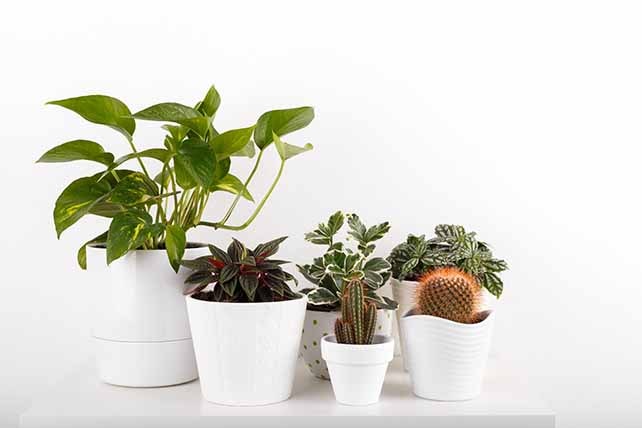Best Air Purifying Plants in India for your Home: Indoor & Outdoor
Air purifying plants are a great option for interior decor, both for their aesthetic looks and the beneficial air cleansing capabilities. If you’re looking for a perfect plant for your home or office, there are plenty of air purifying plants in India to choose from. However, keep in mind that each plant has specific maintenance requirements based on its type, size, and age.
We’ve put together a brief guide about maintaining some of the best air purifying indoor plants in India as well as outdoor ones, along with tips on how to keep the plants healthy and growing. Take a look at some of our top selections and choose the best plant for your home!
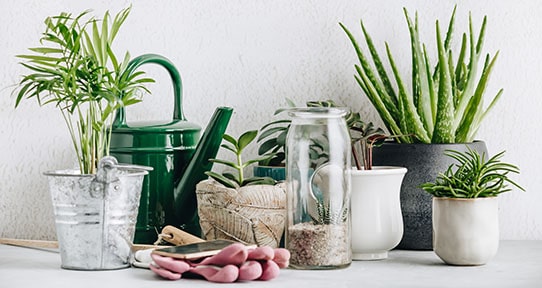
Benefits of Having Air Purifying Plants in your Home
Air purifying plants provide the same benefits as any other houseplant, with the additional benefit of air purification. These plants are scientifically proven to be an efficient air cleanser. This fact is backed up by dozens of research papers and experiments conducted by official organizations. For instance, research done by NASA has proven that all of the plants we’ve listed below have some sort of air purifying capabilities. Here are the overall benefits of air purifying plants for home in India:
- Removing Toxins – Air purifying plants can remove toxic gases from the air such as benzene, trichloroethylene, and formaldehyde. These chemicals are found in common household items and some of them are even found in cigarette smoke.
- Producing Oxygen – It is well known that plants produce oxygen and thus improve the quality of air in your environment. The human body takes in oxygen when breathing and releases carbon dioxide. Plants, on the other hand, consume that same carbon dioxide to produce more oxygen. That way, they maintain the optimal levels of oxygen in the air, which is always a plus.
- Releasing Moisture – Indoor plants also release moisture vapor and contribute to the humidity of the air around them. Several plants in one room can significantly increase the humidity of the space and thus prevent respiratory difficulties caused by dry air.
- Improving Health – Researches at Kansas State University has proven that indoor pans can speed up recovery rates of surgical patients. They also contribute to lower stress and, thus lower heart rates and blood pressure, which can aid in recovery processes.
- Improving Focus – A study at the Royal College of Agriculture in England has proven that students can focus on their tasks more efficiently if they are surrounded by plants. It is recommended to place at least two plants in classrooms and study spaces to increase focus and efficiency.
Take a Look at the Best Air Purifying Plants India
Chrysanthemum

The Chrysanthemum plant often called the Florist’s daisy, is one of those indoor plants that can’t get enough of direct sunlight. This plant loves being exposed directly to sunshine, and it only requires a medium amount of water. It’s not the most demanding indoor plant, so you won’t have to worry about it every day. Besides brightening the room, this plant can purify the air and remove common air particles such as benzene, formaldehyde, xylene, toluene, and trichloroethylene.
While the Florist’s daisy is very easy to maintain and it doesn’t require too much time on your part, there’s one thing you should keep in mind. The plant is highly poisonous to animals and, in case your pet ingests any part of it, make sure to take the animal to the vet immediately.
Summary: Although poisonous to animals, the Chrysanthemum is a very common and efficient air purifying plant available online and in local florist shops.
Peace Lily

The Peace Lily, also known as the Spathiphyllum, is an evergreen plant that’s very easy to take care of. As one of the best indoor plants for air purification, Peace Lily can efficiently remove many airborne compounds including the most harmful ones, such as formaldehyde, benzene, and trichloroethylene.
Keep in mind that this plant is toxic to ingest both for humans and animals. If you have a pet, be careful not to let fallen leaves stay on the ground for too long. When it comes to maintenance, the Peace Lily requires occasional watering, and unlike the Florist’s daisy, it shouldn’t be placed in direct sunlight.
Summary: The Peace Lily plant is one of the most efficient plants for air purification in India because it removes the most common volatile organic compounds found in different environments.
Areca Palm

Unlike the previous two plants, the Areca palm is not toxic and won’t harm your pet. This small plant originates from Madagascar, where it got used to bright outdoor light. While it does love the outdoors, the Areca palm can grow very well in indoor environments as well, as long as you place it at a bright spot near a window.
This plant needs a lot of water during spring and summertime and less of it during winter. The watering patterns will differ depending on the season. When it comes to air purification, the Areca palm can efficiently remove chemicals such as xylene, formaldehyde, trichloroethylene, and carbon monoxide.
Summary: The Areca palm is a nontoxic indoor plant known for its great air purification capabilities. Besides eliminating the common airborne compounds, this plant can also remove carbon monoxide from the air.
Holy Basil (Tulasi)

Next up is the India Basil, also known as Tulasi. This traditional Indian plant was commonly used by Indian ancestors in the daily pooja ritual. With its interesting history and origin, this plant became popular for purifying indoor air and spreading good energy. It removes all common air polluters including xylene and formaldehyde.
Moreover, Tulasi grows rapidly and it needs only a few hours of direct sunshine per day. What makes it a great choice for newbie plant owners is that this plant requires little to no maintenance whatsoever. It’s also not poisonous at all and you can even chew on its leaves or add them to green tea for extra flavor.
Summary: The India basil plant is a traditional indoor purifier used in Indian rituals and even in cooking. It removes common air polluters and spreads good energy through the environment.
Money plant (Epipremnum aureum)

The Money Plant is more commonly known as Golden Pothos. Some remember it after its Latin name – Epipremnum aureum. Either way, the Money Plant is known to be a great air purifier and it is almost indestructible. That means the plant will most likely survive even in poor conditions, which makes it a good choice for you if you don’t have much experience with growing indoor plants.
However, keep in mind that the Money plant can grow up to 8 feet long and it is very toxic to animals. Speaking of toxins, the plant removes common air polluters including formaldehyde, xylene, toluene, benzene, and carbon monoxide. Keep the plant away from direct sunlight and water it only when the soil dries out.
Summary: The Money plant doesn’t require much maintenance and it will likely survive even if you forget to water it a few times. The plant serves as an efficient air purifier and beautiful addition to any room.
Aloe Vera
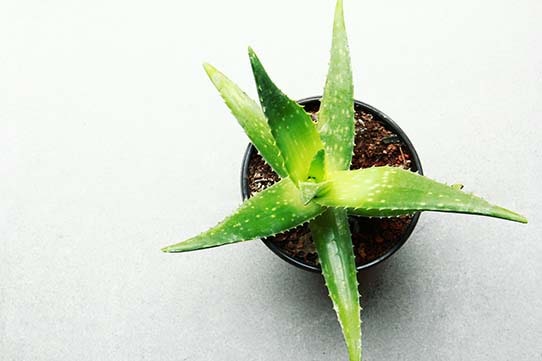
Being one of the most popular plants, Aloe Vera is one of the best air purifying plant that clears formaldehyde and benzene from the air. The plant is very easy to grow both indoors and outdoors and it looks great in all sorts of environments. The leaves of Aloe Vera retain a lot of water, so you won’t have to water the plant too often.
It grows best in a spacious pot placed in areas with low to medium sunlight conditions. Besides purifying the air, Aloe Vera is used for many health purposes, so it will bring along more benefits than you would expect.
Summary: Aloe Vera is one of the most popular succulent plants for indoor air purification in India. It is also used for other health purposes and looks great in any indoor space.
Lucky Bamboo

Lucky Bamboo is a very unique plant that can grow both in potted soil and in a container with water. The plant itself can efficiently remove benzene and trichloroethylene from the air. It also helps restore moisture and maintain humidity in the room, which can reduce respiration issues.
Lucky Bamboo is a great plant for air conditioned spaces because it restores moisture efficiently. When it comes to maintenance, potted Lucky Bamboo plants require watering once per week to keep the soil moist but not too wet. If your plant is growing in a container, make sure to change its water regularly.
Summary: Lucky Bamboo is one of the most unique plants for air purification in India that can grow both in a pot and in a bowl with water. Even though it is called Bamboo, this plant is a member of the Dracaena plant family, not the Bamboo family.
Chinese Evergreens

The Chinese evergreen plants comes from the tropical forests in Asia, where it has developed its colorful and uniquely patterned leaves. It is important to address that the Chinese evergreen requires a bit more attention when it comes to maintenance. The plant should be watered moderately after the soil dries out.
The Chinese evergreen plant also likes to be misted regularly to maintain humidity. It should be re-potted once a year to keep the roots healthy. When it comes to air purification, the Chinese evergreen removes air pollutants such as benzene, carbon monoxide, formaldehyde, and trichloroethylene.
Summary: Although toxic to dogs, this Chinese plant is a great indoor air purifier that will keep the air moist and humidified. However, keep in mind it does require a bit more maintenance effort.
Boston Ferns
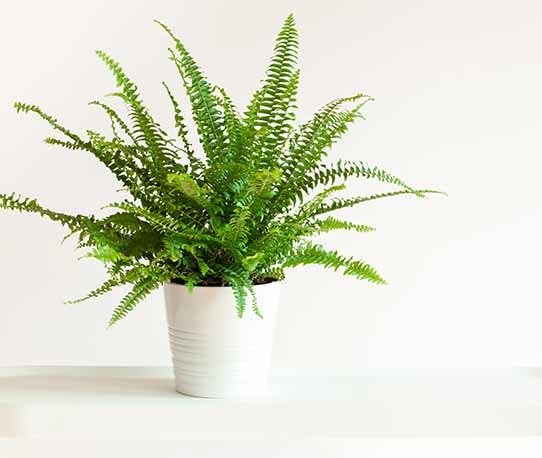
Boston Ferns or the Nephrolepis Exaltata is a non-toxic indoor plant that’s very easy to grow and maintain. It removes toxic gases such as toluene, xylene, and formaldehyde. Moreover, the Boston Ferns plant looks great in a variety of indoor settings so it won’t be a trouble pairing it up with the rest of the interior décor.
The plant itself doesn’t require much trimming and it only needs a medium amount of water and light. With that said, Boston Ferns is very easy to grow so you won’t have to worry about long term maintenance.
Summary: Boston Ferns is a powerful air purifier that’s easy to grow in low to medium light environments. It doesn’t require much water either, which makes it a good choice for newbie plant growers.
Gerbera
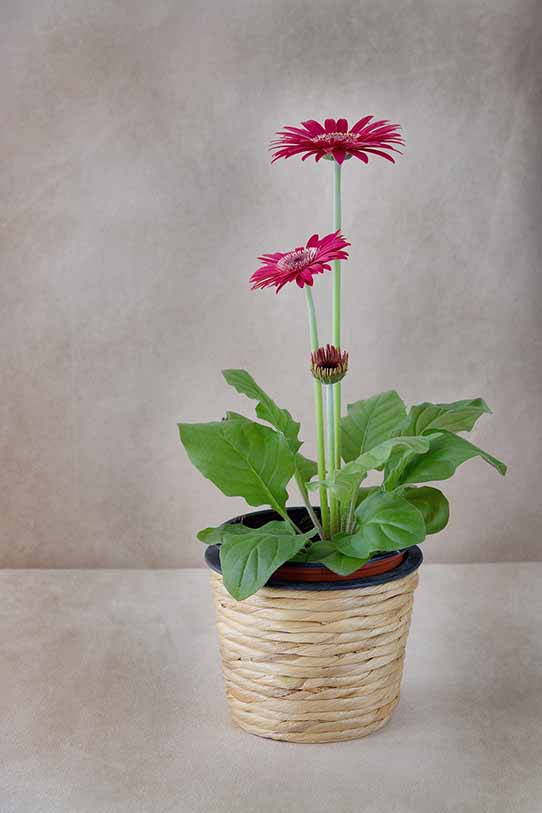
The Gerbera, aka the Barberton Daisy, is a unique plant native to Eastern Africa. As one of the best air purifying plants for home in India, the Gerbera can efficiently remove the harmful formaldehyde, benzene, and trichloroethylene from the air.
As far as maintenance goes, this plant prefers direct exposure to sunlight and plenty of water. If you have an empty spot near the window with plenty of natural light, the Gerbera plant will be a perfect fit for your home.
Summary: The Gerbera plant is a powerful air purifier that can withstand a wide range of temperatures. However, it prefers natural sunlight and plenty of water on a daily basis.
Dracaena

The Dracaena is an upright evergreen shrub with narrow leaves. This green and yellow colored shrub are one of the most popular air purifiers on the market, mainly because it doesn’t require much attention.
It doesn’t take much to keep a Dracaena plant alive. All it needs is a bit of moist soil and indirect sunlight. Dracaena is very well-known for its air purification abilities, as it removes the most common VOCs from the air including benzene, xylene, and trichloroethylene.
Summary: The Dracaena plant will look great in any indoor setting and it won’t need much attention on your part. However, keep in mind that its leaves can be toxic to dogs and other animals.
Snake plant
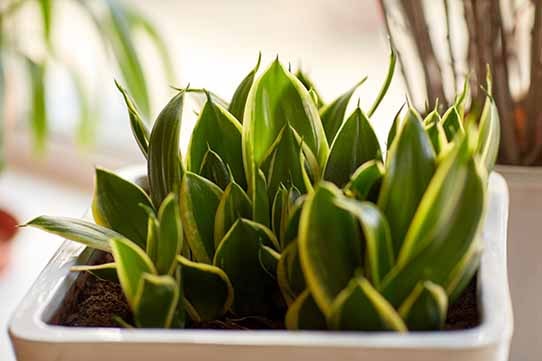
The Snake Plant is a perennial plant that improves indoor air quality, as the NASA research shows. This plant removes airborne toxins such as nitrogen oxide, benzene, xylene, and formaldehyde. Even though native to Western Africa, the Snake plant grows all over the world.
When it comes to maintenance, you need to remember that the snake plant prefers plenty of bright light and it should never be overwatered. Since the plant enjoys direct exposure to sunlight, it can also be grown in outdoor conditions.
Summary: The Snake Plant is a very powerful air purifier that’s easy to grow both indoors and outdoors. However, make sure not to overwater the plant, as this could cause the roots to rot.
Weeping Fig

The Weeping Fig is yet another air purifying plant popular in India, also known as Ficus benjamina. This is a low maintenance plant that can grow well both indoors and outdoors. Keep in mind that the Weeping Fig doesn’t like direct sunlight, so make sure to give it plenty of shade during the daytime.
This plant removes airborne toxins such as formaldehyde, xylene, and toluene. Even though it does require frequent watering, you should allow the soil to dry first to avoid rotting. The Weeping Fig grows best in areas with higher temperatures and humidity levels above 50%.
Summary: The Weeping Fig is an aesthetically pleasing air purifier that will brighten your indoor environment and keep the air clean and breathable.
Azalea
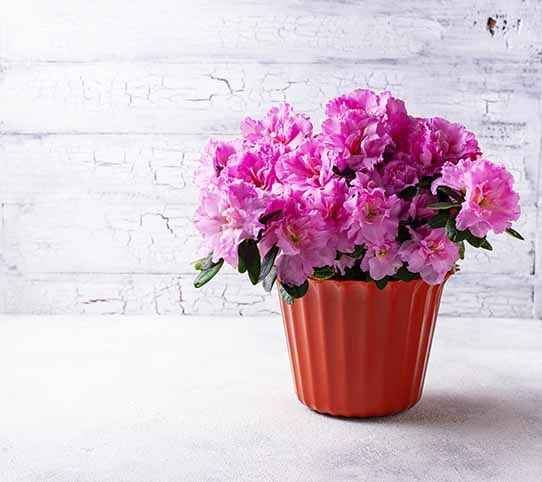
The Azalea plant, also known as Rhododendron simsii, is a blooming plant with flowers of various colors. While the Azalea is very pretty to see in indoor spaces, it’s colorful flowers are not the only thing it has to offer. In fact, this bright plant is capable of purifying the air by removing formaldehyde, one of the most common airborne toxins found in households.
The Azalea prefers bright but cool areas, meaning it shouldn’t be placed under direct sunlight. It will also require an occasional trim and watering if you want to keep it in good shape.
Summary: The Azalea plant is a blooming air purifier that likes bright areas and cooler temperatures. If you don’t mind the occasional trimming, then Azalea can be a great fit for your indoor space.
Spider plant

The Chlorophytum comosum or the Spider Plant is another aesthetic air purifier plant that will brighten up any space. This plant looks great in hanging baskets in indoor spaces and it even produces small white blossoms in the spring. The Spider Plant is a very low maintenance plant, which makes it a great choice for office areas.
It requires watering two to three times per week and it’s not toxic to pets nor to animals. When it comes to air purification, Spider plant eliminates formaldehyde and xylene from the air. Overall, it’s an interesting plant that will not only enhance the interior design but also boost the quality of air.
Summary: The Spider Plant is an efficient air purifier that removes toxins such as xylene and formaldehyde. It doesn’t require much maintenance, which makes it a good choice for office spaces.
English Ivy

Also known as the European Ivy or Hedera Helix, English ivy is an aesthetic indoor plant that removes airborne toxins such as toluene, xylene, formaldehyde, and benzene. Its efficient air purification also helps reduce mold inside your home.
The English Ivy is medium-sized evergreen climbing vine that requires very low maintenance and attention. However, keep in mind that the plant spreads aggressively. so you might have to trim it every now and then. The English Ivy requires plenty of water, direct sunlight and it can also be grown outdoors.
Summary: English Ivy is a great choice for those who prefer evergreen plants. It is an efficient air purifier and will help reduce mold in indoor spaces.



